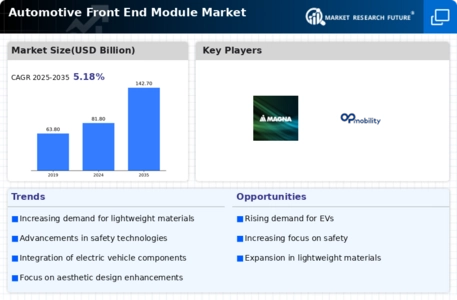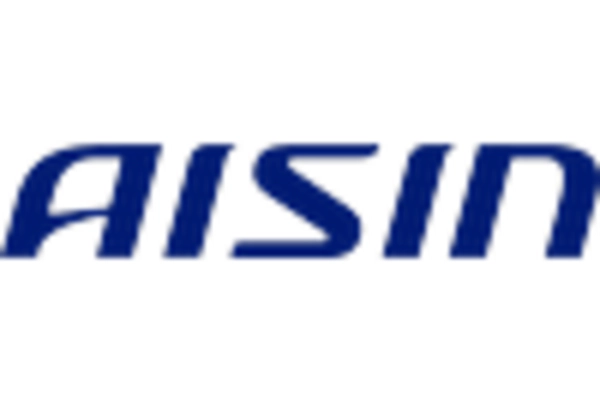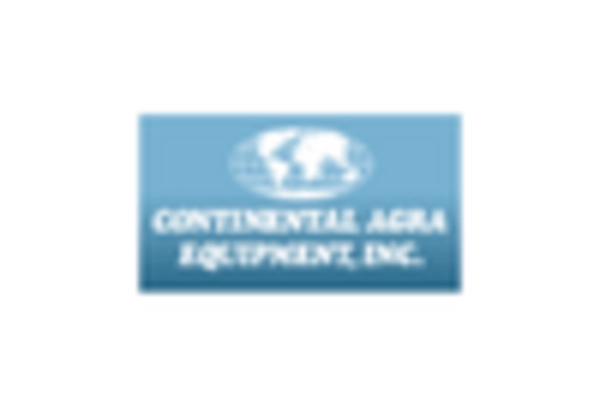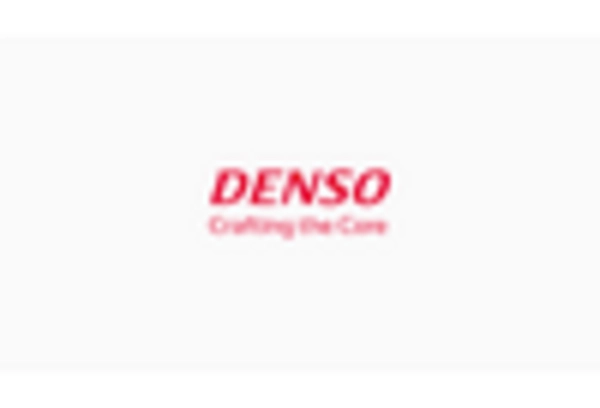-
REPORT PROLOGUE
-
INTRODUCTION
-
DEFINITION
-
SCOPE
- RESEARCH OBJECTIVE
- ASSUMPTIONS
-
OF THE STUDY
-
2.2.3.
-
LIMITATIONS
-
MARKET STRUCTURE
-
MARKET SEGMENTATION
-
RESEARCH
-
METHODOLOGY
-
RESEARCH PROCESS
-
PRIMARY RESEARCH
-
SECONDARY
-
MARKET SIZE ESTIMATION
-
FORECAST MODEL
-
MARKET
-
DYNAMICS
-
DRIVERS & OPPORTUNITIES
-
CHALLENGES & RESTRAINTS
-
VALUE CHAIN ANALYSIS
-
PORTER’S FIVE FORCES ANALYSIS
-
5.
-
AUTOMOTIVE FRONT END MODULE MARKET, BY MATERIAL
-
INTRODUCTION
-
5.2.
-
STEEL
-
COMPOSITE
-
PLASTIC
-
OTHERS
-
AUTOMOTIVE
-
FRONT END MODULE MARKET, BY COMPONENTS
-
INTRODUCTION
-
HEADLIGHTS
-
FRONT GRILL
-
RADIATOR
-
CONDENSER
-
HORN ASSEMBLY
-
OIL COOLER
-
OTHERS
-
AUTOMOTIVE FRONT END MODULE MARKET, BY
-
VEHICLE
-
INTRODUCTION
-
PASSENGER
-
COMMERCIAL
-
8.
-
AUTOMOTIVE FRONT END MODULE MARKET, BY REGION
-
INTRODUCTION
-
NORTH
- U.S.
- CANADA
- MEXICO
- REST
-
AMERICA
-
OF NORTH AMERICA
-
EUROPE
- U.K.
- GERMANY
- REST OF EUROPE
-
8.3.3.
-
FRANCE
-
ASIA–PACIFIC
- CHINA
- INDIA
- JAPAN
- REST OF ASIA-PACIFIC
-
ROW
- BRAZIL
- RUSSIA
- OTHERS
-
COMPANY LANDSCAPE
-
INTRODUCTION
-
COMPETITIVE STRATEGY ANALYSIS
-
COMPANY PROFILE
-
Mahle GmbH
- COMPANY OVERVIEW
- INDUSTRY /BUSINESS
- FINANCIAL UPDATES
- KEY DEVELOPMENTS
-
SEGMENT OVERVIEW
-
Faurecia SA
- COMPANY OVERVIEW
- INDUSTRY /BUSINESS
- FINANCIAL UPDATES
- KEY DEVELOPMENTS
-
SEGMENT OVERVIEW
-
Denso Corporation
- COMPANY OVERVIEW
- INDUSTRY /BUSINESS
- FINANCIAL UPDATES
- KEY DEVELOPMENTS
-
SEGMENT OVERVIEW
-
Calsonic Kansei Corporation
- COMPANY OVERVIEW
- INDUSTRY
- FINANCIAL UPDATES
- KEY DEVELOPMENTS
-
/BUSINESS SEGMENT OVERVIEW
-
Hbpo Group
- COMPANY OVERVIEW
- INDUSTRY /BUSINESS
- FINANCIAL UPDATES
- KEY DEVELOPMENTS
-
SEGMENT OVERVIEW
-
Magna International Inc.
- COMPANY OVERVIEW
- INDUSTRY
- FINANCIAL UPDATES
- KEY DEVELOPMENTS
-
/BUSINESS SEGMENT OVERVIEW
-
Hyundai Mobis
- COMPANY OVERVIEW
- INDUSTRY /BUSINESS
- FINANCIAL UPDATES
- KEY DEVELOPMENTS
-
SEGMENT OVERVIEW
-
Plastic Omnium
- COMPANY OVERVIEW
- INDUSTRY /BUSINESS
- FINANCIAL UPDATES
- KEY DEVELOPMENTS
-
SEGMENT OVERVIEW
-
SL Corporation
- COMPANY OVERVIEW
- INDUSTRY /BUSINESS
- FINANCIAL UPDATES
- KEY DEVELOPMENTS
-
SEGMENT OVERVIEW
-
Valeo S.A
- COMPANY OVERVIEW
- INDUSTRY /BUSINESS
- FINANCIAL UPDATES
- KEY DEVELOPMENTS
-
SEGMENT OVERVIEW
-
MRFR CONCLUSION
-
APPENDIX
-
LIST OF TABLES
-
Global Automotive Front End Module Market: By Material, 2024-2030 (USD
-
Billion)
-
Steel: Automotive Front End Module Market, By Region, 2024-2030
-
(USD Billion)
-
Composite: Automotive Front End Module Market, By Region,
-
Plastic: Automotive Front End Module Market,
-
By Region, 2024-2030 (USD Billion)
-
Others: Automotive Front End Module
-
Market, By Region, 2024-2030 (USD Billion)
-
Global Automotive Front
-
End Module Market: By Component, 2024-2030 (USD Billion)
-
Headlight:
-
Automotive Front End Module Market, By Region, 2024-2030 (USD Billion)
-
Table
-
Front Grill: Automotive Front End Module Market, By Region, 2024-2030 (USD Billion)
-
Radiator: Automotive Front End Module Market, By Region, 2024-2030 (USD
-
Billion)
-
Condenser: Automotive Front End Module Market, By Region,
-
Horn Assembly: Automotive Front End Module
-
Market, By Region, 2024-2030 (USD Billion)
-
Oil Cooler : Automotive
-
Front End Module Market, By Region, 2024-2030 (USD Billion)
-
Others:
-
Automotive Front End Module Market, By Region, 2024-2030 (USD Billion)
-
Table
-
Global Automotive Front End Module Market: By Vehicle, 2024-2030 (USD Billion)
-
Passenger: Automotive Front End Module Market, By Region, 2024-2030 (USD
-
Billion)
-
Commercial: Automotive Front End Module Market, By Region,
-
Global Automotive Front End Module Market:
-
By Region, 2024-2030 (USD Billion)
-
North America: Automotive Front
-
End Module Market, By Material, 2024-2030 (USD Billion)
-
North America:
-
Automotive Front End Module Market, By Component, 2024-2030 (USD Billion)
-
Table
-
North America: Automotive Front End Module Market, By Vehicle, 2024-2030 (USD
-
Billion)
-
North America: Automotive Front End Module Market, By Country,
-
U.S.: Automotive Front End Module Market,
-
By Material, 2024-2030 (USD Billion)
-
U.S.: Automotive Front End Module
-
Market, By Component, 2024-2030 (USD Billion)
-
U.S.: Automotive Front
-
End Module Market, By Vehicle, 2024-2030 (USD Billion)
-
Canada: Automotive
-
Front End Module Market, By Material, 2024-2030 (USD Billion)
-
Canada:
-
Automotive Front End Module Market, By Component, 2024-2030 (USD Billion)
-
Table
-
Canada: Automotive Front End Module Market, By Vehicle, 2024-2030 (USD Billion)
-
Rest of North America: Automotive Front End Module Market, By Material,
-
Rest of North America: Automotive Front End
-
Module Market, By Component, 2024-2030 (USD Billion)
-
Rest of North
-
America: Automotive Front End Module Market, By Vehicle, 2024-2030 (USD Billion)
-
Europe: Automotive Front End Module Market, By Material, 2024-2030 (USD
-
Billion)
-
Europe: Automotive Front End Module Market, By Component,
-
Europe: Automotive Front End Module Market,
-
By Vehicle, 2024-2030 (USD Billion)
-
Europe: Automotive Front End Module
-
Market, By Country, 2024-2030 (USD Billion)
-
U.K.: Automotive Front
-
End Module Market, By Material, 2024-2030 (USD Billion)
-
U.K.: Automotive
-
Front End Module Market, By Component, 2024-2030 (USD Billion)
-
U.K.:
-
Automotive Front End Module Market, By Vehicle, 2024-2030 (USD Billion)
-
Table
-
Germany: Automotive Front End Module Market, By Material, 2024-2030 (USD Billion)
-
Germany: Automotive Front End Module Market, By Component, 2024-2030
-
(USD Billion)
-
Germany: Automotive Front End Module Market, By Vehicle,
-
France: Automotive Front End Module Market,
-
By Material, 2024-2030 (USD Billion)
-
France: Automotive Front End
-
Module Market, By Component, 2024-2030 (USD Billion)
-
France: Automotive
-
Front End Module Market, By Vehicle, 2024-2030 (USD Billion)
-
Italy:
-
Automotive Front End Module Market, By Material, 2024-2030 (USD Billion)
-
Table
-
Italy: Automotive Front End Module Market, By Component, 2024-2030 (USD Billion)
-
Italy: Automotive Front End Module Market, By Vehicle, 2024-2030 (USD
-
Billion)
-
Rest of Europe: Automotive Front End Module Market, By Material,
-
Rest of Europe: Automotive Front End Module
-
Market, By Component, 2024-2030 (USD Billion)
-
Rest of Europe: Automotive
-
Front End Module Market, By Vehicle, 2024-2030 (USD Billion)
-
Asia-Pacific:
-
Automotive Front End Module Market, By Material, 2024-2030 (USD Billion)
-
Table
-
Asia-Pacific: Automotive Front End Module Market, By Component, 2024-2030 (USD
-
Billion)
-
Asia-Pacific: Automotive Front End Module Market, By Vehicle,
-
Asia-Pacific: Automotive Front End Module
-
Market, By Country, 2024-2030 (USD Billion)
-
China: Automotive Front
-
End Module Market, By Material, 2024-2030 (USD Billion)
-
China: Automotive
-
Front End Module Market, By Component, 2024-2030 (USD Billion)
-
China:
-
Automotive Front End Module Market, By Vehicle, 2024-2030 (USD Billion)
-
Table
-
India: Automotive Front End Module Market, By Material, 2024-2030 (USD Billion)
-
India: Automotive Front End Module Market, By Component, 2024-2030 (USD
-
Billion)
-
India: Automotive Front End Module Market, By Vehicle, 2024-2030
-
(USD Billion)
-
Japan: Automotive Front End Module Market, By Material,
-
Japan: Automotive Front End Module Market,
-
By Component, 2024-2030 (USD Billion)
-
Japan: Automotive Front End
-
Module Market, By Vehicle, 2024-2030 (USD Billion)
-
Rest of Asia-Pacific:
-
Automotive Front End Module Market, By Material, 2024-2030 (USD Billion)
-
Table
-
Rest of Asia-Pacific: Automotive Front End Module Market, By Component, 2024-2030
-
(USD Billion)
-
Rest of Asia-Pacific: Automotive Front End Module Market,
-
By Vehicle, 2024-2030 (USD Billion)
-
ROW: Automotive Front End Module
-
Market, By Material, 2024-2030 (USD Billion)
-
ROW: Automotive Front
-
End Module Market, By Component, 2024-2030 (USD Billion)
-
ROW: Automotive
-
Front End Module Market, By Vehicle, 2024-2030 (USD Billion)
-
ROW:
-
Automotive Front End Module Market, By Country, 2024-2030 (USD Billion)
-
Table
-
Brazil: Automotive Front End Module Market, By Material, 2024-2030 (USD Billion)
-
Brazil: Automotive Front End Module Market, By Component, 2024-2030 (USD
-
Billion)
-
Brazil: Automotive Front End Module Market, By Vehicle, 2024-2030
-
(USD Billion)
-
Russia: Automotive Front End Module Market, By Material,
-
Russia: Automotive Front End Module Market,
-
By Component, 2024-2030 (USD Billion)
-
Russia: Automotive Front End
-
Module Market, By Vehicle, 2024-2030 (USD Billion)
-
Others: Automotive
-
Front End Module Market, By Material, 2024-2030 (USD Billion)
-
Others:
-
Automotive Front End Module Market, By Component, 2024-2030 (USD Billion)
-
Table
-
Others: Automotive Front End Module Market, By Vehicle, 2024-2030 (USD Billion)
-
Automotive Front End Module, by Region, 2024-2030 (Units)
-
Table
-
Automotive Front End Module, by Key players, 2024-2030 (Units)
-
LIST OF FIGURES
-
Global Automotive Front End Module market segmentation
-
Forecast Methodology
-
Five Forces Analysis of Global Automotive
-
Front End Module Market
-
Value Chain of Global Automotive Front End
-
Module Market
-
Global Automotive Front End Module Market: By Material,
-
Global Automotive Front End Module Market:
-
By Component, 2024-2030 (USD Billion)
-
Global Automotive Front End
-
Module Market: By Vehicle, 2024-2030 (USD Billion)
-
Global Automotive
-
Front End Module Market: By Region, 2024-2030 (USD Billion)
-
North
-
America Automotive Front End Module Market: By Country, 2024 (%)
-
FIGURE 10
-
Europe Automotive Front End Module Market: By Country, 2016 (%)
-
Asia-Pacific
-
Automotive Front End Module Market: By Country, 2024 (%)
-
ROW Automotive
-
Front End Module Market: By Country, 2024 (%)
-
Automotive Front End
-
Module, by Region, 2024 (%)
-
Automotive Front End Module, by Key players,
-
Market Development Analysis, 2024-2030 (%)









Leave a Comment